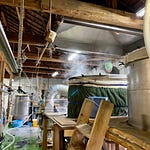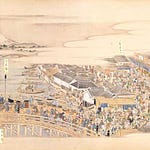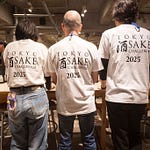Welcome to Issue#115 of SIN.
Two significant things happen around this time of year: rice planting, and the “rainy season”. One of these brings more joy than the other.
Many farmers have planted their rice-plant seedlings for the impending growing season, which will run from now, through the summer, and into the fall. The rice harvested in September or October will be used to brew sake in late 2024. Predictions are for another mercury-busting summer, which will likely mean a less-than-favorable harvest of hard rice. However, all is not lost. Many brewers are skilled enough that the quality of rice isn’t cause for concern, but rather just a call to change tactics. Others have learned through experience over the past few years how to manage rice of less than ideal condition out of necessity.
Science is telling us that climate conditions quite simply will not be going back to the “good old days”, so learning to adapt is the only way forward.
If only there was a way for the rest of us to adapt to the sticky, humid, muggy rainy season.
And now for the news…
Home Is Where The Sake Is
Aomori- The oldest brewery in Aomori Prefecture will be returning to its original location following financial turmoil and management struggles.
Takenami Shuzōten was founded around 1645 in the town of Itayanagi-machi, under the first brewing license issued in the prefecture. The brewery operated for 370 years, producing well-known brands such as Iwaki Masamune and Shichirobee. Due to financial and logistic issues, sake production was moved off-premise to facilities formerly run by Osanai Shuzōten (maker of Akegarasu) in Tsugaru City in March 2019. However, the brewery’s troubles continued, not only financially, but the change in the brewing environment saw the brewery struggle to maintain product quality because the water in Tsugaru was so different. In March 2020 the brewery declared bankruptcy.
However, investors have breathed new life into the brewery, allowing the Takenami family to resume brewing, and also providing enough resources to fund a restoration and renovation of the original brewing facilities in Itayanagi-machi.
In September this year, 17th generation Yoshiaki Takenami will lead brewing operations at the restored kura using local Itayanagi-machi water.
Takenami describes the traditional sake of his family brewery as, “matured, and rich with umami and a mildness that is best enjoyed warmed.”
New sake from Takenami Shuzōten will be available in early 2025.
Source - Mutsu shimpo
JG: It is somehow reassuring to learn that a brewery that has been around for 370 years will continue to be around for a while longer, and also bring their operations back in house, rather than outsourcing them. Having said that, I have not ever tasted their sake. I have that to look forward to, which means another trip to Aomori.
竹浪酒造店(岩木正宗、七郎兵衛), 長内酒造店 (明ケ烏)
What’s He Been Up To?
Ibaraki- Many in the sake world were surprised when legendary toji, Tatsuya Ishikawa left Taketsuru Shuzō after 26 years and soon announced plans to head up operations at Tsukinoi Shuzōten in Ibaraki Prefecture in 2020.
Tsukinoi Shuzōten was founded in 1865 in Oarai City, long known as a fishing town. The sake of the region has traditionally been enjoyed to celebrate and pray for the safety and prosperity of the fishing trade.
Like many breweries, COVID hit Tsukinoi Shuzōten hard as sales dropped by up to fifty percent. Upon Ishikawa’s resignation from Taketsuru Shuzō, eighth generation kuramoto of Tsukinoi Shuzōten, Naohiko Sakamoto sought out Ishikawa and his renowned skills as a brewer in the kimoto style, to help in his pursuit to create sake that expresses the Oarai region.
Joining a new brewery in the middle of a pandemic was far from ideal timing, so Ishikawa initially held back from fully expressing himself in the sake of his new workplace.
However, the brewing team at Tsukinoi Shuzōten were keen to learn from Ishikawa, and together they began reviewing the sake brewing process for the brewery.
While a lot of modern sake is brewed by a process based on a specific end goal, the sake at Tsukinoi Shuzōten is determined by - and subject to - the climate and the natural environment. They choose not to control the temperature in either the yeast starter (moto), nor in the main fermentation mash (moromi). This is how Ishikawa coaxes the sake to express regionality.
The first new batches were brewed in late 2020, and although Sakamoto at first did not know exactly how Ishikawa’s sake would turn out, he was pleased with the results and felt he had found a profile that represented Oarai well. Sakamoto reached out to regular distributors and suppliers to let them know the sake of Tsukinoi Shuzōten was about to change, and fortunately, he received plenty of positive feedback. Many of the distributors fully embraced the change in direction for the brewery.
As the brewery wraps up its fourth season under Ishikawa, sales and local distribution have improved and the brewery is looking to widen its distribution to the rest of Japan.
Source - Nikkei
JG: I have had the pleasure of knowing Ishikawa-san for a long time and have spent a wee bit of time with him in Hiroshima. Like many, I was surprised to hear about his move, but trusted he knew what he was doing. I am very happy to hear of - and taste - his success. In parallel to the move to Tsukinoi, his reputation has soared over the last few years, and he is currently the head of the organization that oversees all of the toji guilds in Japan.
月の井酒造店 , 竹鶴酒造
Happy Birthday To A True Pioneer
Hyogo- This year brings with it the 60th anniversary of the release of perhaps the most iconic sake in the country: Ozeki One Cup.
For many that live in Japan or have visited there, the Ozeki One Cup is the most ubiquitous sake by a large margin. Its availability in just about every convenience store and supermarket in Japan has made sure that there is likely no one in the country that hasn’t heard of Ozeki One Cup.
Although it may have suffered an image decline as “an old man’s drink”, it wasn’t always so. Ozeki, in Nishinomiya, Hyogo Prefecture, released the one cup - the first of its kind - in 1964 as a celebration of the Tokyo Olympic Games. As a new, affordable and portable way to consume sake, the Ozeki One Cup was a huge hit with young drinkers at the time. In testimony to the popularity and quality of the Ozeki One Cup, it’s those “once-were-young” drinkers that have continued to enjoy the Ozeki One Cup, thus giving it the image as the choice of “older people”.
Maybe bear that in mind the next time you think about wearing your Nirvana 1992 Tour t-shirt in public.
Ozeki One Cup has remained almost entirely unchanged since its first release. However, in recent years, Ozeki has employed the artwork of young artists to bring a modern feel to the back labels for the cup products in hopes of appealing to a new generation.
Whether you’re a fan of the Ozeki One Cup or not, its history as the first cup sake, which went on to spawn countless imitators, cements its reputation as one of the true pioneers of the sake industry.
Happy 60th!
JG: Happy Kanreki Ozeki One Cup! However, we should also remember that Ozeki is not just about One Cups. The company makes a wide range of other, well thought-out and delicious products that all share a thread of consistency of style throughout them. The more I get to know them, the more I like and respect their sake.
But also, there are now a large number of other very good sake available in cups. We can’t call them “one cups,” as Ozeki has that name properly secured, but the format that Ozeki created now has a life of its own, and it’s a significant, fun and enjoyable sector of the sake market now.
大関(ワンカップ大関)
Listen to this episode with a 7-day free trial
Subscribe to Sake Industry News to listen to this post and get 7 days of free access to the full post archives.












